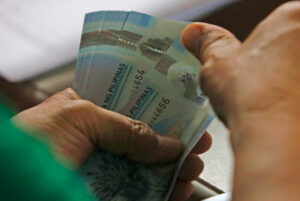Peso may be range-bound on escalating US-China trade war

THE PESO may move sideways against the dollar this week as markets continue to monitor the growing trade war between the United States and China.
The local unit closed at P56.97 per dollar on Friday, strengthening by 38 centavos from its P57.35 finish on Thursday, Bankers Association of the Philippines data showed.
Week on week, however, the peso was down by 14.9 centavos from its P56.821 finish on April 4.
“The peso rose on broad dollar sell-off, still on growing concerns of a recession and the escalating China trade war,” a trader said in a phone interview.
The dollar was generally weaker on Friday as the market continued to react to the Trump administration announcement of a 90-day pause on the “reciprocal” tariffs it imposed on most of its trading partners, Rizal Commercial Banking Corp. Chief Economist Michael L. Ricafort said in a Viber message.
For this week, the trader said the peso’s movements will continue to depend on the developing trade war between the US and China.
The trader sees the peso moving between P56.90 and P57.30 per dollar this week, while Mr. Ricafort said it could range from P56.75 to P57.25.
The dollar continued to slide against major currencies on Friday as the back-and-forth over import tariffs shook investor confidence in the safety of the greenback, sending it to its lowest level in a decade against the Swiss franc and a three-year low versus the euro, Reuters reported.
China increased its tariffs on US imports to 125% from 84% on Friday, retaliating against US President Donald J. Trump’s decision to hike duties on Chinese goods to a total of 145% after pausing many of his latest tariff hikes on most countries.
The dollar has been hit hard by a global sell-off that spread to stocks and even safe-haven US Treasuries. The yields on benchmark 10-year notes were on course for their biggest weekly jump since 2001.
Brad Bechtel, global head of FX at Jefferies, said dollar weakness is being driven partly by the view that US economic exceptionalism is waning — with the potential of a looming recession — and a switch from the dollar as a safe-haven asset to the yen and Swiss franc.
“There’s a great rotation, which is basically foreign investors diversifying away from the US into other regions such as the euro zone. And for those foreign investors still involved in the US, they’re realizing they need to currency hedge their assets. There’s a scramble to do so, which is putting additional pressure on the dollar.”
The greenback was down 0.51% at 144.05 yen after hitting its lowest level since September 2024. It was set for its largest weekly drop since early February.
The dollar index, which measures the greenback against a basket of currencies including the yen and the euro, fell 0.56% to 99.958 — hitting its lowest mark since April 2022. It was on track for its biggest weekly drop since early last month.
“Part of the dollar weakness in the past few weeks has been linked to worries over a recession or the Fed cutting rates, but it’s kind of gone beyond that,” said Win Thin, global head of markets strategy at Brown Brothers Harriman in New York.
“It’s more really loss of confidence and credibility in the dollar and then in US policy making. Typically in risk-off episodes, the dollar should gain as a safe haven, but it’s really been the yen and Swiss franc that have been picking that up, and the dollar has been under pressure.” — Aaron Michael C. Sy with Reuters




